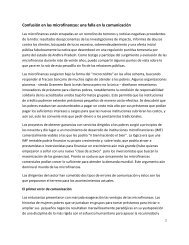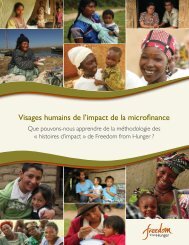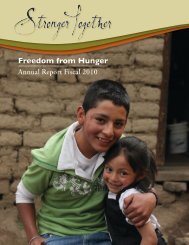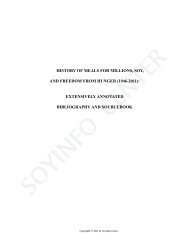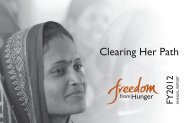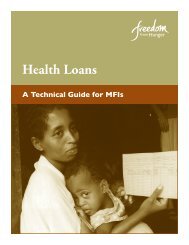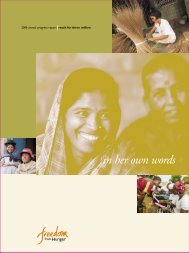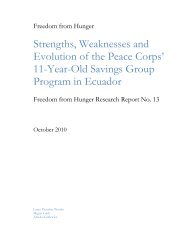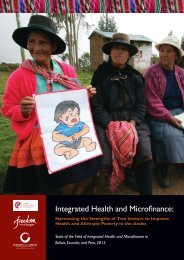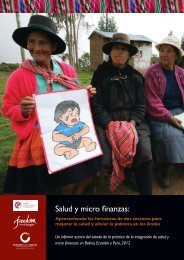English - Freedom from Hunger
English - Freedom from Hunger
English - Freedom from Hunger
You also want an ePaper? Increase the reach of your titles
YUMPU automatically turns print PDFs into web optimized ePapers that Google loves.
part of “the impact of microfinance.” Until we know what some of the long-term changes are (or are not),<br />
we cannot truly judge whether, or how, microfinance works.<br />
If we measure the impact of microfinance in the short term, we should not draw conclusions regarding<br />
long-term effects. We have to determine changes that are reasonable to expect within a short span of time.<br />
For example, when studies look for health outcomes, we know we cannot expect long-term outcomes<br />
(e.g., reduced incidence of a chronic illness) in a short period of time. Instead, we focus on outcomes<br />
likely to be seen shortly after the intervention (e.g., health-seeking behavior). If we hypothesize that<br />
microfinance can improve health outcomes over time, we should apply the same expectations that the<br />
health community holds for its more direct interventions to improve health. If we cannot expect shortterm<br />
changes in response to direct health interventions, how can we expect microfinance, with its indirect<br />
impacts on health, to generate short-term changes? But we know it is possible over the long term, because<br />
there are client stories that suggest it is possible.<br />
In summary, our findings suggest that we have to work harder to align our evaluation goals with what is<br />
possible to measure in the time frames we are given to evaluate. Many microfinance practitioners know<br />
and repeatedly tell stories about a woman who has been in a program for five-plus years, but rigorous<br />
evaluations are telling stories in much shorter time frames. If we only measure short-term change, then we<br />
need to explain the results in the short-term context and indicate that long-term effects are still unknown.<br />
Because the “impact story” methodology offers a chance to follow incoming clients over time, even if<br />
they drop out of the microfinance program, we are likely to discover more about long-term change, as<br />
well as gain a deeper understanding of what type of microfinance works for what type of people. This<br />
information will better equip us to design new products and services.<br />
This research has also revealed additional questions for us to explore. The most pressing question is<br />
whether we are asking the right questions. Here, most of our stories are <strong>from</strong> women, and we understand<br />
their life goals and aspirations to be food, health, education, tranquility in the home and income stability.<br />
Are impact evaluations assessing the impact of microfinance on the self-defined needs of women? What<br />
are the most important short-term measures of success? Is it enough to focus on improvements in the<br />
microenterprise, or should we focus on the secondary effects, such as increased food consumption? How<br />
do we incorporate the poor’s perception of change as a meaningful measure of success? Would we have<br />
detected the life improvements women have told us about in their stories if we instead had looked solely<br />
at quantitative measures of assets?<br />
Finally, is there a paradigm shift in our understanding of how microfinance loans are productive tools<br />
for poverty alleviation? In Portfolios of the Poor iv , we learned how financial diaries revealed complex<br />
financial transactions and multiple financial tools utilized by the poor, microfinance loans being only<br />
one of them. We have also learned in other research that the poor rarely use their microenterprise loans<br />
for a sole purpose—the money is used more like consumption loans. This suggests that clients are using<br />
microenterprise loans more generally to improve their lives rather than just to grow their businesses. Our<br />
impact stories give a glimpse into that dynamic. Families also talk about how the loan was used to pay for<br />
health expenses, to pay off other debt, to pay for their children’s schooling, even to improve their home.<br />
ConClusIon<br />
23



